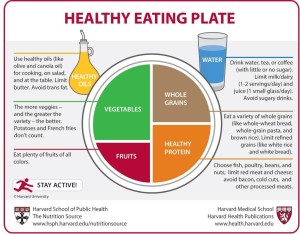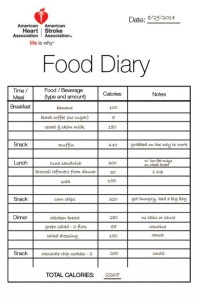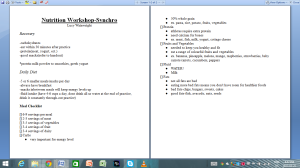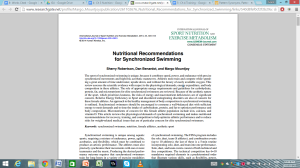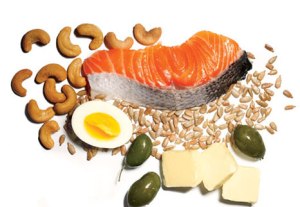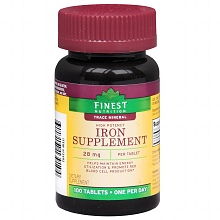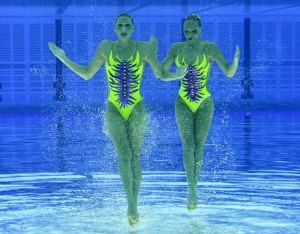Every athlete needs to fuel their body in order to excel in their chosen sport and depending on that sport there are different diets that support the necessary body type the athlete is required to have in order to excel. For synchronized swimmers they want to be a mix of all three body types focusing mainly on the mesomorphic qualities.
3.1 Recreational Level Nutrition
In the recreational stream of synchro there is not much that coaches can do to control what the athletes do or what they eat. Recreational athletes practice between one and half and four hours a week at Nepean Synchro Swim Club. (http://www.nepeansynchro.com/2014-15-recreational-season/program-info-2014-2015-1) That being said since there isn’t a specific body type or cellular makeup that is required for the recreational level their diet also isn’t much of a concern. They are not elite enough athletes for their diet to significantly affect their performance at competitions though coaches highly encourage their athletes to eat healthily in the few weeks leading up to a competition. It is unfortunate that it is not encourage as a lifestyle choice and is only encouraged leading up to the competitions of the season. Whether they do that or not is up to their own discretion and they cannot be punished by the coach if they don’t. As a recreational synchronized swimmer the athletes should be eating healthily to fuel their body. They should be avoiding large consumption of foods such as fast foods, high sugar foods, sodas, pop, and high sodium foods as just a couple of examples. They should focus on eating organic and nutrient rich foods that will fuel their body in smaller quantities than a giant meal of only carbohydrates. Having a balanced and healthy diet can make athletes feel better working out and make performing even the littlest bit easier. In a healthy meal athletes and regular people should be eating most vegetables with some fruits and then the other half of the plate is evenly divided between whole grains and a healthy protein. Instead of having a sugary drink people should drink water at meal times and only use healthy oils such as olive oil in their cooking. This is a different philosophy from the competitive program and a very different philosophy from the Olympic training program.
3.2 Competitive Level Nutrition
Competitive swimmers are more closely watched than the recreational swimmers but again they cannot be punished for not eating appropriately. It depends on their coach and what they decide to do though they are all generally encouraged to eat as healthy as possible in the weeks leading up to a competition and specifically the week right before. Also while at the competition whether it be out of town or in town the coach is able to monitor what the athletes are eating more as well as supply healthier options for them to pick from while away. Some coaches will even do a food log for their athletes to record their meals in and the kinds of foods that they are eating. Some coaches chose to do those for the few weeks before a competition or every month during the season. It depends on the coach and in Nepean Synchro there are no specific regulations as to what the coaches should be doing with the athletes in respect to food logs.
A few years ago Nepean Synchro had Lucy Wainwright, an Olympic paddler with a Bachelor of Sport Science and Physical Education. She came and did a workshop on how to properly fuel our bodies during recovery, on a daily basis, as well as what to include in our meals. This was an interesting opportunity for all the athletes and below are the notes that were taken during her workshop. (Wainwright, L. (2015)) (http://canoekayak.ca/wp-content/uploads/2014/06/Nutrition-for-the-Developing-Athlete-Lucy-Wainwright.pdf)
The coaches recognize that athletes need to replenish their fuel stores and give swimmers snack breaks between dryland and water session as well as in the middle of a long practice to ensure the athletes were fueled for the entire practice and there were no dangers of injuring themselves. In the competitive program that is about the extent that the coaches are allowed to instruct the athletes for what they are allowed to eat. After that it is the athlete’s responsibility to fuel their body so that they can be successful in their sport. For the athletes to do well however a certain diet would help fuel their body in the most efficient way possible. To do so, athletes should be fuelling to their specific body type, whether it be ectomorph, mesomorph, or endomorph. Specifically for synchro swimmers with, generally, the mesomorphic body type they need to be keeping in mind what the article, “Eating for your Mesomorph Body Type” from www.coachcalorie.com, when eating their meals and planning their diets. ( Schober, T. (2012))
Source: ( Schober, T. (2012))
Eating For Your Mesomorph Body Type
Characteristics of a mesomorph:
- Have little problem putting on muscle.
- Not very difficult to stay lean.
- Excel at bodybuilding and sports.
- Good insulin sensitivity.
- Good thyroid output.
- Good metabolic rate.
- Good testosterone levels.
- Good growth hormone levels.
The mesomorph is a lucky individual. He/she can usually be fairly lax with their diet and still end up muscular and lean. With good testosterone and growth hormone levels, they have the ability to add muscle and keep a low body fat percentage much more easily.
A mesomorph should eat the recommended 1 gram/lb of bodyweight in protein, but they need to be a bit more mindful of their carbohydrate intake. While they may do just as well eating a moderate to high carbohydrate diet as an ectomorph, it would be wise to implement nutrient timing into their diet. Keeping their carbohydrate intake timed around breakfast and their pre and post-workout meals tends to work best.
Many people would be surprised to know that they are actually mesomorphs that have just been a bit too lax with their nutrition over the years. Your somatotype is not based on what you look like now, but on what you are genetically predisposed to look like. With a little more mindfulness towards your diet and exercise program, your true somatotype can show.
( Schober, T. (2012)) (http://www.coachcalorie.com/eating-for-your-body-type/)
Competitive athletes need to make sure they are getting enough protein for their body to maintain their muscle mass and body fat percentages. They also need to be eating enough carbohydrates to fuel their bodies during training sessions as well as during the recovery period. ( Schober, T. (2012))
A meal that a synchronized swimmer should eat after a practice would be a healthy quinoa salad with a light dressing and avocado, lots of vegetables, and black beans. The combination of the quinoa and black beans provides a lot of protein to help repair the torn muscles from practice as well as the healthy fats from the avocado are very good for the athletes and helps them to absorb vitamins such as A, D, E, and F. There are also lots of carbohydrates in the vegetables which helps to replenish the glycogen stores which were depleted during the practice. Overall it is a very good meal to help an athletes body recover for the next practice. In general athletes should be avoiding things such as highly processed foods, fast foods, pops, high sugar food items and high salt food items. This just helps them to maintain a healthier body to help their performance and help them feel healthy for competitions.
3.3 Olympic Level Nutrition
Olympic level athletes train at very high levels and need to be fueling their body accordingly to support this heavy training program. They need to be constantly monitoring their carbohydrate, protein, fat, and micronutrients they are consuming on a daily basis. “The nutritional requirements of synchronized swimmers vary depending on the training phase and the volume and intensity of the work being performed. (…) Researchers used a doubly labeled water method for measuring total energy expenditure (TEE) of elite Japanese synchronized swimmers during moderately intense training and determined that the mean TEE was 11.5 MJ/day (SD = 2.8), or 2,738 kcal/day (SD = 672)” (Robertson, S., Benardot, D., & Mountjoy, M. (2014)) Athletes need to counter the amount of energy expended before practices in order to be able to endure the entire practice. They need to properly fuel their body with the necessary nutrients in order to be successful and optimize their practice times.
“Olympic-level synchronized swimmers have a high volume and high-intensity training program of 7 hr/day for 6 days/week (Mountjoy, 2009). The training regimen involves not only the synchro-specific pool training but also additional training in weights, ballet, Pilates, speed swimming, acrobatics, flexibility, and conditioning.” (Robertson, S., Benardot, D., & Mountjoy, M. (2014)) To support this incredible amount of training, Olympic synchro swimmers must fulfill all the necessary energy requirements and maintain the appropriate levels of carbohydrates, protein, fat, key micronutrients, iron, calcium, vitamin D, and hydration. This is best highlighted in the following quote from the research report Nutritional Recommendations for Synchronized Swimmers, “ Food choices should be relatively high in carbohydrates, nutrient dense, easily accessible, and easily digestible to enable training at a high intensity during training sessions. Ideally, athletes should choose a well-balanced diet that is sufficient in energy, carbohydrates, and protein to optimize training performance.” (Robertson, S., Benardot, D., & Mountjoy, M. (2014))
Starting with carbohydrates, swimmers are recommended to consume in the range of 5-7 g/kg/day of body weight spaced out across the day in frequent intervals, including before, during and after training sessions. The main goal of consuming carbohydrates is to provide fuel for the muscles to allow them to perform in the way the athlete intends them to. Foods that contain carbohydrates include vegetables, whole grains, fruits, and beans. Keeping their daily diet healthy with whole grain buns and including beans, vegetables, and fruits will better fuel an athlete and give them more energy in the pool. (Magee, E. (2008, October 30))
The starting range of protein required for Olympic synchro swimmers is between 1.5-1.7 g/kg of body weight/day with an emphasis on timing to optimize the effectiveness of the protein during athlete’s workout. “This range provides flexibility and should be individualized on the basis of the athlete’s requirements. Athletes should be encouraged to meet protein requirements by including high-quality, protein-rich foods at all meals and snacks, evenly spaced throughout the day.” (Robertson, S., Benardot, D., & Mountjoy, M. (2014)) Protein rich foods include avocados, greek yogurt, cottage cheese, steak, halibut, dried lentils, nuts, tofu, and quinoa. Combining these with your carbohydrates such as vegetables and beans would be a great start to a fuel rich plate of food. (Kadey, M. (2015, June 19))
The next nutrient that is important in a synchro swimmers diet is fat since it provides essential fatty acids, fat-soluble vitamins, and energy to the athlete. Olympic swimmers should have a total fat energy intake of 20-25% and if the fat levels in their diet are too low then it can result in a compromisation of the immune system. (Robertson, S., Benardot, D., & Mountjoy, M. (2014)) Foods such as salmon, nuts, eggs, cheese, and avocados are all full of healthy fats that your body needs in order to absorb vitamins A, D, E, and F. Without these fats athletes bodies would not be able to get the nutrients they needs in order to perform to the elite level that these athletes are looking for.
Photo: http://www.womenshealthmag.com/files/wh6_uploads/images/1205-fat.jpg
Next up are vitamins since “certain minerals are important for the energy metabolic processes through oxygen transfer and nerve impulse transmission of muscle cells” (Robertson, S., Benardot, D., & Mountjoy, M. (2014)) Deficiencies of iron and calcium in athletes is very common, especially in female athletes, and the athlete will have to take supplements to help maintain the necessary mineral levels in their body. The only issue with this is that some vitamin supplements may contain prohibited substances that are not listed on the label and can cause issues with the Olympic committee and whether the athlete should be allowed to compete or not.
The first mineral is iron, which for synchro swimmers, is hard to come by since it is such a female dominated sport and women can be susceptible to having lower iron as a result of menstruation. Iron is required for oxygen-transporting compounds, such as hemoglobin, in order to circulate oxygen around the blood stream, which as we know, is very important for synchro swimmers. A deficiency in iron can lead to inadequate carrying of oxygen to the muscles and body which can also negatively affect the endurance and attention span of the athlete with the deficiency. Synchro swimmers also lose a low amount of iron through their sweat but since synchro swimmers sweat profusely and don’t even realize it since they are in the water, the risk of becoming dehydrated and low on iron is higher. “It is estimated that the typical diet in industrialized nations provides 6 mg of iron per 4.2 MJ (1,000 kcal) of energy. This requires that synchronized swimmers have an average energy consumption of approximately 2,500 kcal/day to satisfy the dietary intake of iron.” (Robertson, S., Benardot, D., & Mountjoy, M. (2014)) Swimmers can enrich their diet with iron by eating red meat, and spinach as two examples of iron rich foods. They can also take iron supplements to get the iron that they need in a day, whether it be to get that last little bit of iron that they need or get all their daily iron from a supplement if an iron rich diet is not possible for that athlete.
(Photo:http://pics.drugstore.com/prodimg/415450/220.jpg)
Calcium is also an important mineral for synchro swimmers to be consuming since it sustains a normal pH of the blood as well as helps clot blood and aids in the transfer of nerve transmission. There aren’t any studies done on synchronized swimmers specifically and iron but one was done on elite gymnasts who have the same kind of body image. It found that “elite gymnasts often demonstrate an inadequate intake of energy and several nutrients, primarily iron and calcium; a low intake of calcium, coupled with a low vitamin D exposure/intake, may predispose athletes to stress fractures” (Robertson, S., Benardot, D., & Mountjoy, M. (2014)) This is concerning for athletes who wish to avoid injury as much as possible but cannot help it if their body is simply not strong enough to withstand their sport, which is what happens when you have a deficiency of minerals. Athletes should have a calcium intake of 1, 500 mg/day to maintain healthy and strong bones. That being said a synchro swimmer should intake between 1, 000 and 1, 500 mg/day through a combination of food and/or supplements. (Robertson, S., Benardot, D., & Mountjoy, M. (2014)) Calcium rich foods include milk or any dairy product, oranges, bok choy, kale, broccoli, okra and almonds. Having these included in an athletes diet will help them maintain a healthy and strong body that can go through the wear and tear of hours in the pool being beaten up accidentally by team mates. (http://www.health.com/health/gallery/0,,20845429,00.html)
Another important mineral is Vitamin D which can be useful for muscle contractions, muscle protein anabolism, improving immune function, and enhancing anti inflammatory action, all of which are very useful for a synchro swimmer. The article Nutrition Recommendations for Synchronized Swimmers suggests that synchro swimmers should be having periodic blood tests done to monitor the amount of vitamin D in their system and increase it if necessary. Fat is required in order to absorb this vitamin which is why you should eat vitamin D rich foods such as mushrooms, fortified milk, and beef liver along with some fats like nuts and avocados. (http://www.health.com/health/gallery/0,,20504538,00.html)
Hydration is also very important for any athlete, not just a synchro swimmer. Failure to hydrate the body compromises the athlete’s performance by “lowering blood volume, thereby compromising the sweat rate (and therefore the cooling capacity), interfering with the optimum delivery of nutrients to working muscles, and interfering with the removal of metabolic by-products from working muscles.” (Robertson, S., Benardot, D., & Mountjoy, M. (2014)) “Given the normal reduction in blood glucose during exercise, the hydration beverage should contain approximately 100 mg of sodium per 240 ml and approximately 6% carbohydrate.” (Robertson, S., Benardot, D., & Mountjoy, M. (2014)) That being said it is very important for synchronized swimmers to be consuming enough fluids before, during, and after their practices to sustain their health and perform to their fullest. Swimmers should always have a water bottle by the side of the pool and drink one to two of these bottles per 2-3 hour practice as well as a bottle before and a bottle after.
Synchro swimmers also spend a majority of their time upside down in the water and can suffer from gastrointestinal upset. This can be caused by eating large volumes of food or certain types of high fiber, gas-producing foods, such as peppers and onions. Avoid eating gas producing foods such as asparagus, brussel sprouts, broccoli, peaches, pears, corn, potatoes, milk, oatmeal, beans, and sodas or soft drinks before a practice. By doing so the athlete reduces the chances of gastrointestinal upset. If it cannot be avoided then an antacid can be taken to prevent it, though it is better to simply avoid eating gas causing foods before a practice or perfomance. (Robertson, S., Benardot, D., & Mountjoy, M. (2014), Rodriguez, D. (2012, December 28))
Photo bottom right: http://www.modernism.ro/wp-content/uploads/2012/08/swimmers.jpg
3.3a Recovery Nutrition
“The goal of recovery nutrition is to replace fluid and muscle glycogen and to optimize restoration of muscle glycogen between training sessions. Therefore, athletes should be encouraged to consume foods high in carbohydrate within the first 15–30 min after training, because the timing of post exercise carbohydrate intake affects glycogen synthesis. Recovery guidelines from Burke et al. (2004) recommend 1.0–1.2 g of carbohydrate per kg of body weight consumed at frequent intervals (0–4 hr) immediately after training. Nutrient-rich carbohydrate foods with a moderate to high glycemic index provide a readily available source for muscle glycogen synthesis and should be the foods of choice in recovery meals (Burke et al., 2004). Drinking additional fluid during recovery is also important. According to Burke et al. (2006), consuming small amounts of protein within the carbohydrate-rich meals can also help athletes achieve other nutritional goals such as adequate protein intake.” (Robertson, S., Benardot, D., & Mountjoy, M. (2014)). All these techniques for recovery contribute to the athlete’s body restoring muscle glycogen, preventing dehydration, and preparing for the next big competition or event. These recovery nutrition routine can often be interrupted by interviews, family, photos, or awards ceremonies so it is important that the athletes tend to their bodies as much as possible. They should try and get the recovery routine done before anything gets in the way or shortly after the distractions leave. Recovery snacks should include foods that contain carbohydrates to refuel, protein to rebuild muscles, and sodium and potassium to replenish lost electrolytes from sweating. Examples of recovery meals are peanut butter and jelly sandwich, chocolate milk, and yogurt and a banana. It doesn’t have to be a big snack, even just 100 calories will help to start the recovery process. (http://synchroswim.isport.com/synchronized-swimming-guides/nutrition-guide-for-synchronized-swimmers)
3.4 In Summary
Overall synchro swimmers should be focusing on their diet to maintain their appropriate body type, and at the Olympic level, the required aesthetic build. They do this by looking at everything they eat and focusing on eating the proper amounts of carbohydrates, protein, fats, and vitamins, as well as staying hydrated. All these elements combined with the athlete’s body will optimize the training methods that the athlete completes in order to be at the level of sport that they wish to be at. (Robertson, S., Benardot, D., & Mountjoy, M. (2014))
